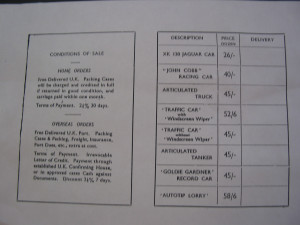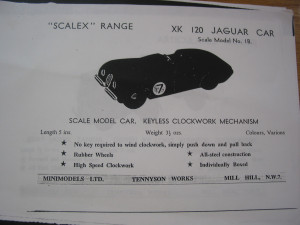When Phil wrote this article he was talking about collecting models that were some 30-40 years old – its become a far harder task now. That said the Grandprix cars surface often and we do at the moment have some beautiful Austin Healey examples- The boxed cars are really sought after and hard to find-
ROOTS OF SCALEXTRIC-THE MINIMODELS YEARS 1947 TO 1959
By Phil Etgart
Anyone who has read any of the articles I have written will know how enthusiastic I am about the range of tinplate models produced by Minimodels under the Scalex, Startex and eventually Scalextric brand names,
Whilst most people are aware that the Minimodels was owned and operated by Fred Francis and eventually sold to the Lines Brothers Tri-ang empire, Little is normally known about the early output of the company,
Minimodels was formed in 1947, and was based at Tennyson works, Tennyson Rd, Mill Hill, London NW7, The company was one of a large number of toy producers operating in and around London, Whilst the smaller toy companies were primarily focused on Die-Cast and slush molded toys e,g, companies such as ‘Johilco’ (John Hill & Company) and ‘Crescent’, a number of operators produced toys that were based on a combination of tinplate and Bakelite, The majority of these toys were generally push along toys or key wound clockwork models.
Toys with any degree of inter-activity or innovation were rare, and indeed it was not unusual for small companies to survive making crude copies of the more prominent brands,
From the beginning of Minimodels Fred Francis was obviously approaching things from a slightly different perspective, The company’s first product was a charming lithographed tinplate toy typewriter, which was launched under the name ‘MiniType’, It is unclear how long this model remained in production but the 1952 trade catalogue that follows this article suggests that it was already out of production even that early in the company’s history,
It is difficult to assess exactly what was issued and in which sequence, but the catalogue clearly shows the company’s transition toward model cars and its continual innovation,
Fairly soon after ‘Mini-Type’ it is believed the company introduced it’s range of tinplate lorries, Absolute clarification of what was issued is lacking, and information from the broader toy trade is conflicting, but all of the items shown in the trade catalogue are known to exist
The tinplate articulated lorries are reasonably easy to locate through specialist antique Tin Toy dealers, Although expect a little paint or very minor corrosion damage, Mintboxed items are generally not around!
The ‘Autotip lorry’, a tinplate Tipper Truck with working forward/reverse gears, working tipping bed and driver who peers out of window, is a different story, Whilst I know of one or two examples in collections I have yet to see, let alone find an example myself
The ‘Traffic Car’ turns up reasonably frequently although I am not sure how rare respective versions with & without working windscreen wipers are, Presumably Minimodels were also unsure of the markets desire for a car with working windscreen wipers as it was unique for them to issue two versions of a model with & without specific features,
Whilst the ‘Traffic Car’ was the company’s first venture towards model cars, it was not really indicative of the direction the company was going to develop in, That was provided by the companies next release which was what should be regarded as it’s first venture into producing replicas of competition cars.
The model in question was a key wound clockwork tinplate replica of John Cobb’s land speed Railton powered streamliner. The model appears to exist in three versions. Sprayed Silver with UK & US flags crossed on the nose. Sprayed Silver with plain Blue flags crossed on the nose. Plain polished metal with usual screen painted flags/signature on the body.
These cars are hard to find in anything that would normally be regarded as approaching VG to Excellent condition. Boxed examples are extremely rare as the boxes were manufactured from particularly thin card. Surviving examples are worth tracking down as the box art is especially nice with line drawings of Cobb & his car and a brief passage of text regarding his land speed attempt.
Following on from the Cobb Railton was a model of Lt/Col Goldie Garner land speed MG streamliner. The MG was produced in two colours, Red or British Racing Green. The Green being especially difficult to obtain. Boxed examples are even more scarce than boxed Cobb Railtons. The MG was notable as it was the first model in which Fred Francis fitted his patented fifth wheel self winding clockwork mechanism, which was to form the basis of the soon to be issued Scalex series.
The 1952 trade catalogue clearly illustrates that as with Fred Francis recollections on the Scalextric video, the Jaguar XK Roadster was indeed the first Scalex model to be issued and appeared in 1952.
The Jaguar was soon joined by a tinplate model of an Aston Martin DB2 and in turn by an MGTF, which was unusual in that the complex body shape demanded an aluminum rather than tin pressing. The three sports cars were then joined by two Grand Prix cars a Maserati and a Ferrari. All of the models featured the patented fifth wheel winding mechanism.
Subsequently Minimodels issued two inore models in the Scalex range. An Austin Healey 100/4 and the seventh and last in the series a Jaguar 2.4 Saloon.
The Healey 100/4 can be difficult to find a nice example of, and the Jaguar 2.4 is by far the rarest of the Scalex range. The Jaguar was only produced for a brief period before the Scalex range was superceded by the Startex range.
Early ‘Scalex’ cars came in a Dark Blue/White print box, but this was soon replaced by a very colourful box which had a press out panel to make it into a pit building. Consequently, boxed Scalex cars can be hard to find. Boxed Austin Healey l00/4’s turn up occasionally and boxed Scalex Jag’ s are virtually impossible to find.
Around 1955 Minimodels introduced a new series of models, it’s ‘Startex’ range. This comprised of re-works of two earlier ‘Scalex’ models and one completely new model. ‘Startex’ differed from ‘Scalex’ in that it no longer utilised the innovative fifth wheel winding mechanism and now relied upon a cord winding system. This was either disguised as the exhaust pipe (in the case of the Healey & Jaguar 2.4) or the steering wheel in the case of the Sunbeam Alpine Roadster.
The Healey was modified from the Scalex range by changing the shape of the grille to replicate a 100/6 and through the addition of a windscreen & screen frame. The Jaguar 2.4 lost it’s pressed tin interior and gained smoked out windows, but retained it’s delightful appearance.
The Startex Jaguar’s turn up reasonably frequently, but boxed examples are rare. The Healey 100/6 is rare in any condition boxed or unboxed!
The Alpine appears to have been the biggest seller of the Startex range by a large margin as they turn up regularly. Screens on the Alpine are particularly vulnerable as
they were often broken by a swiftly released winder cord hurtling back toward its resting place on the dashboard.
By 1956 it was becoming apparent that Minimodels needed a new product. The toy market was beginning to change rapidly in the light of high quality low cost pocket/pocket money toys such as Lesney’s newly introduced range of ‘Matchbox’ toys.
Fred Francis had already noted the popularity of wire cars & rail cars being raced by specialists clubs and the idea of a buried rail track system and electric motor powered ‘Slot Cars’ was born during a visit to a trade fair.
Minimodels initially introduced Scalextric (Scalex Electric) with a rubber track system utilising battery power and push button controllers (no graduation of power supply. Just on and off!).
The cars were a modified version of the tinplate Scalex Maserati which was fitted with an electric motor which was mounted around/over the rear axle and a gimble pick up (like two half spheres sandwiched together).
The ‘Scalextric’ system was an instant success and the Maserati was soon followed by a motorised version of the Scalex Ferrari. As with the Maserati, this car also came fitted with a rubber driver.
During late 1958 a publicity leaflet appeared which announced three additions to the Scalextric range. It showed electric versions of the Jaguar 2.4 saloon, the Austin Healey 100/6 and the Aston Martin DB2. The Healey soon appeared, but it was around this time that the takeover of Minimodels by Tri-ang put paid to the tinplate Scalextric range due to Tri-ang’s existing injection moulding capacity. Underpans for the tinplate electric Sunbeam Alpine and Jaguar 2.4 saloon eventually surfaced (see
>
page 22 of Roger Gilhams book) but no further trace exists. Whilst the existence of a tinplate electric Aston Martin DB2 in an NSCC members possession has been suggested, it has never been substantiated.
Whilst with painted models it can be difficult to be certain what was produced ( e.g. ‘Matchbox’ Friday afternoon specials) the following represents a list of models & colours that are known to exist:
The tinplate range finally ceased production in 1959 drawing to a close the first chapter of the history of Scalextric.
My Thanks to John Carmichael for providing the photocopies of 1952 trade catalogue – which follows the article.
The development & marketing of the product was supported by the production of a ‘Scalextric Bulletin’ often refereed to as tinplate newsletters. These ran to six editions (although an issue eight is alleged to exist), issue six being the one which announced the cessation of the tinplate range and introduction of plastic bodied cars post Triang’s takeover of Minimodels.
The owners club also produced an enamel broach, which is now extremely difficult to find, as are the ‘Bulletins’ themselves.
So what format does your collection take?
Check out our web site
www.scalemodels.co.uk
and ebay store
https://www.ebay.co.uk/str/markscalemodels
for our latest stock of cars/catalogues and of course reproduction spares.









